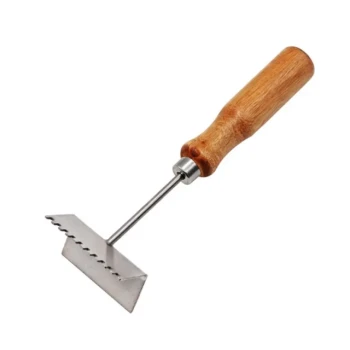At its core, removing detached honeycomb is a fundamental practice of apiary biosecurity and pest management. While it may seem like a minor housekeeping task, leaving stray pieces of comb and honey near your hives exposes your colonies to a significant and cascading set of risks.
Leaving detached honeycomb on the ground is an open invitation for problems. It acts as a powerful attractant for pests, a potential vector for devastating diseases, and can trigger aggressive robbing behavior that can destroy weaker colonies.

The Immediate Threat: Pests and Predators
A piece of fallen comb is a concentrated package of carbohydrates (honey) and protein (pollen), broadcasting a powerful scent that attracts a wide range of unwanted visitors to your apiary.
The Obvious Culprit: Ants
The sweet scent of honey is an irresistible lure for ants. A trail leading back to a small piece of comb on the ground can quickly become a trail leading directly into your hive, where ants can overwhelm a colony, consume brood, and steal resources.
The Silent Destroyers: Wax Moths and Hive Beetles
Stray comb provides a perfect, undefended breeding ground for major hive pests like wax moths and small hive beetles. Allowing them to establish a population just outside the hive dramatically increases the chances of a full-blown infestation within your colonies.
The Opportunists: Wasps, Hornets, and Vertebrates
The scent of honey and wax also attracts yellow jackets, hornets, and larger animals like skunks, raccoons, or even bears. These creatures are drawn in for the easy meal but may then turn their attention to the hives themselves, preying on bees or attempting to break into the colonies.
The Hidden Danger: Disease Transmission
Beyond attracting pests, discarded comb is a significant biosecurity hazard that can facilitate the spread of serious bee diseases.
How Dropped Comb Becomes a Vector
Spores of devastating brood diseases, most notably American Foulbrood (AFB), can remain viable in old comb and honey for decades. A bee from a healthy hive that finds and robs this contaminated comb can carry the disease back to its own colony.
The Risk to Your Apiary and Beyond
This single act can initiate an outbreak that spreads through your entire apiary. Foraging bees can also carry these pathogens to other apiaries in the area, making poor hygiene a threat to the wider beekeeping community.
Understanding the Trade-offs: The Cost of Negligence
The decision to leave a piece of comb on the ground is often one of convenience, but the potential costs of this small oversight are immense.
The "It's Just One Piece" Fallacy
It is easy to underestimate the impact of a small fragment of burr comb. However, a bee's sense of smell is exceptionally acute. A single, undefended source of honey is enough to trigger a chain reaction of pest attraction and robbing.
Creating a Robbing Frenzy
When bees discover an easy, undefended source of nectar or honey, it can incite a "robbing" instinct. They become agitated and frenzied, searching for the source. This can lead them to attack weaker neighboring hives, creating chaos in the apiary and often resulting in the death of the robbed colony.
Increased Workload and Expense
Failing to remove comb ultimately creates more work. The consequences—infestations, disease outbreaks, and dead-outs—require far more intervention, treatment, and expense than the simple act of cleaning up in the first place.
How to Apply This to Your Project
Adopting a strict "no comb on the ground" policy is one of the simplest and most effective ways to protect your investment and the health of your bees.
- If your primary focus is pest prevention: Recognize that stray comb is a powerful pest beacon and remove it immediately to eliminate the food source.
- If your primary focus is disease control: Treat every piece of discarded comb as a potential disease vector and handle it with proper biosecurity in mind.
- If your primary focus is maintaining a calm apiary: Understand that exposed honey can trigger robbing, and diligent cleanup is key to preventing hive-on-hive aggression.
Practicing good apiary hygiene transforms you from a reactive beekeeper into a proactive guardian of your colonies' health.
Summary Table:
| Risk Category | Key Threats | Consequence |
|---|---|---|
| Pests & Predators | Ants, Wax Moths, Hive Beetles, Wasps, Vertebrates | Infestation, resource theft, brood loss |
| Disease Transmission | American Foulbrood (AFB) spores | Colony outbreak, spread to other apiaries |
| Apiary Instability | Robbing behavior triggered by exposed honey | Hive aggression, weaker colony destruction |
Protect Your Apiary with Professional-Grade Equipment
As a commercial beekeeper or distributor, your apiary's health is your livelihood. Don't let a simple oversight like stray honeycomb compromise your colonies and profits.
HONESTBEE supplies durable, efficient beekeeping supplies and equipment designed specifically for the demands of commercial-scale operations. Our wholesale-focused solutions help you maintain superior apiary hygiene, manage pests effectively, and prevent costly disease outbreaks.
Ready to strengthen your biosecurity and operational efficiency?
Contact HONESTBEE today to discuss your equipment needs and discover how our products can support a healthier, more productive apiary.
Visual Guide

Related Products
- Professional Long-Handled Silicone Honey Scraper for Beekeeping
- Professional Wide Blade Honey Scraper for Beekeeping and Honey Processing
- HONESTBEE Advanced Ergonomic Stainless Steel Hive Tool for Beekeeping
- Stainless Steel Scraper for Metal Queen Bee Excluders
- Heavy Duty Stainless Steel Frame Cleaner with Plastic Handle
People Also Ask
- How can a capping scratcher be used with an electric knife? Boost Efficiency and Honey Yield
- What other tools are available for honey uncapping besides knives? Find the Right Tool for Your Apiary's Scale
- Why is uncapping necessary in honey harvesting? Unlock Your Honey Yield & Preserve Comb
- What type of bees are better adapted to certain climatic conditions? Match Bee Strategy to Your Climate for Success
- What tools are available for uncapping honey? A Guide to Choosing the Right Tool for Your Operation



















